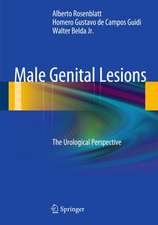The Ureter
Editat de H. Bergmanen Limba Engleză Paperback – 20 oct 2011
Preț: 1148.53 lei
Preț vechi: 1208.98 lei
-5% Nou
Puncte Express: 1723
Preț estimativ în valută:
219.84€ • 238.88$ • 184.79£
219.84€ • 238.88$ • 184.79£
Carte tipărită la comandă
Livrare economică 21 aprilie-05 mai
Preluare comenzi: 021 569.72.76
Specificații
ISBN-13: 9781461259091
ISBN-10: 1461259096
Pagini: 800
Ilustrații: 780 p.
Dimensiuni: 210 x 280 x 42 mm
Greutate: 1.76 kg
Ediția:Softcover reprint of the original 2nd ed. 1981
Editura: Springer
Colecția Springer
Locul publicării:New York, NY, United States
ISBN-10: 1461259096
Pagini: 800
Ilustrații: 780 p.
Dimensiuni: 210 x 280 x 42 mm
Greutate: 1.76 kg
Ediția:Softcover reprint of the original 2nd ed. 1981
Editura: Springer
Colecția Springer
Locul publicării:New York, NY, United States
Public țintă
ResearchDescriere
This volume, focusing on the ureter and the diseases which involve it, is an updated second edition. Many journals and textbooks deal with the physiology, pathology, diagnosis, and therapy of derangements of the urinary tract. In most instances, however, the discussion properly centers on the disease process itself and its primary aspects, with only a tan gential description of effects on the ureter. The editor is therefore correct that the ureter itself should be considered a major organ. Though it has been regarded in the recent past as a simple muscular tube, reacting to stretching or filling by contraction, this simplistic view of ureteral phys iology is changing fast. With expanded knowledge of ureteral physiology, a pharmacology is developing which is becoming useful to the clinician in many ways. One of the most interesting aspects of the ureter is its role in inducing the permanent kidney, the metanephros. Relatively slight displacements in the origin of the ureteral bud result in ectopic ureteral orifices and a wide range of congenital anomalies. An ureteral bud which arises medial to the normal position at the genu of the mesonephric duct results in a lateral, and usually incompetent, ureterovesical junction after the duct is taken up to form a portion ofthe trigone. This appears certainly to be the developmental mechanism which results in primary reflux.
Cuprins
1. Development of the Ureter.- 2. Histology of the Ureter.- 3. Anatomy and Ultrastructure of the Ureter.- 4. Principles of Ureteral Physiology.- 5. Pathology of the Ureter.- 6. Effect of Drugs on the Ureter.- 7. Clinical Application of Hydrodynamics of the Ureter and Renal Pelvis.- 8. Ureteral Reconstitution.- 9. Splinting Versus Nonsplinting in Ureteral Surgery.- 10. Diseases of the Ureter.- 11. Idiopathic Retroperitoneal Fibrosis.- 12. Ureteral Calculi.- 13. Ureteral Tumors.- 14. Radical Versus Conservative Therapy for Primary Carcinoma of the Ureter.- 15. Radiographic Examination of the Ureter.- 16. Cineradiography of the Ureter.- 17. Radioisotopes (Radionuclides) in Diagnosis and Management of Ureteral Disorders.- 18. Ureterorenoscopy and Transurethral Endoscopic Surgery of the Ureter and Renal Pelvis.- 19. The Role of Radiation Therapy in Primary Carcinoma of the Ureter.- 20. Ureteral Injury as a Consequence of Radiation Therapy.- 21. Injuries of the Ureter.- 22. Autotransplantation for Extensive Ureteral Disease.- 23. Prevention of Ureteral Injuries and Medicolegal Aspects.- 24. Surgical-Legal Aspects of Ureteral Injury.- 25. Vesicoureteral Reflux.- 26. Megaureter.- 27. The Ureter in Pediatrics.- 28. The Ureter in Obstetrics and Gynecology.- 29. Congenital Anomalies of the Ureter.- Retrocaval Ureter: Diagnosis and Management.- Discussion.- 30. Ureteral Replacements.- 31. The Ureter in Renal Transplantation.- The Ureter in Pediatric Renal Allotransplantation.- 32. The Ureteral Stump.- 33. Obstruction at the Ureteropelvic Junction.- 34. Ureteral Diversion.- 35. Preparation of the Patient for Ureteral Surgery.














